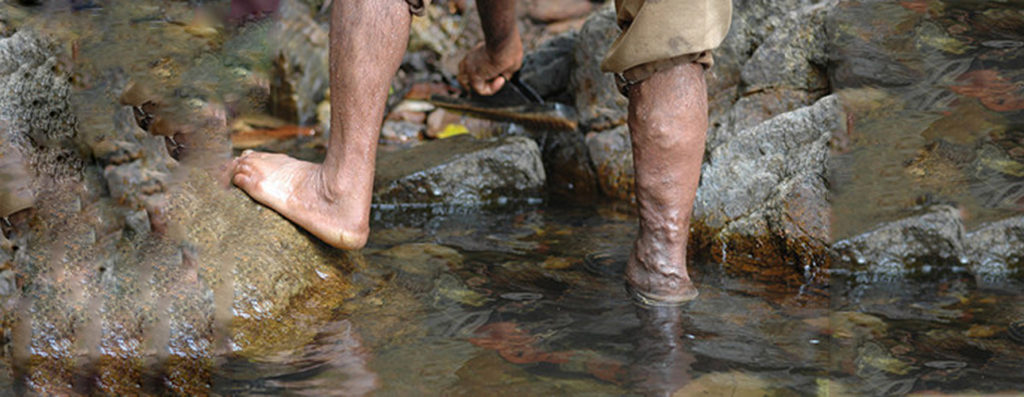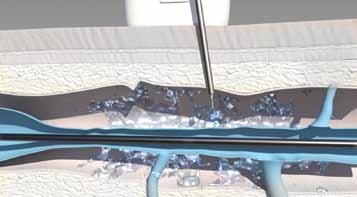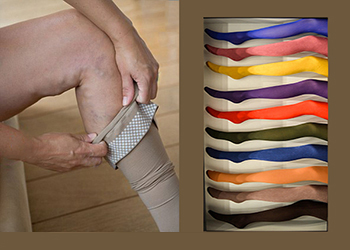Varicose Vein Treatments
Successful treatment depends on careful pre-operative assessment. The choice of treatments is varied and most people require more than one type of treatment to effectively deal with their veins. Our aim is to use the most effective modern techniques, with the minimum of discomfort and the best cosmetic result.
Options available
There are many different treatment options such as:
- Endovenous Treatments (laser – EVLT / radio-frequency ablation – VNUS)
- Sclerotherapy (Foam / Clarivein)
- Cyanoacrylate Glue (Venaseal)
- Conventional Treatment (Compression Stockings / Traditional surgery)
Endovenous Treatment (VNUS / EVLA)
Endovenous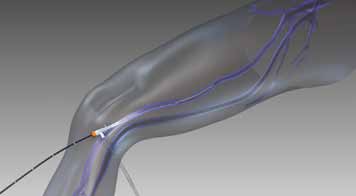 thermal ablation is a minimally invasive treatment that involves the insertion of a thin, flexible tube called a catheter into a diseased vein to seal it shut using heat. Blood that would normally return toward the heart through these veins will then travel through other veins instead. Over time the treated vein shrinks and is absorbed by the body. Compared with surgical options like ligation and vein stripping, endovenous ablation results in less pain and quicker recovery time. It is usually carried out under local anaesthetic however some patients prefer to have a general anaesthetic for the procedure.
thermal ablation is a minimally invasive treatment that involves the insertion of a thin, flexible tube called a catheter into a diseased vein to seal it shut using heat. Blood that would normally return toward the heart through these veins will then travel through other veins instead. Over time the treated vein shrinks and is absorbed by the body. Compared with surgical options like ligation and vein stripping, endovenous ablation results in less pain and quicker recovery time. It is usually carried out under local anaesthetic however some patients prefer to have a general anaesthetic for the procedure.
Radio-frequency ablation (VNUS):
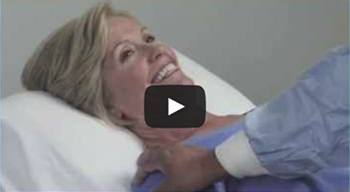 This is the only minimally invasive procedure to use segmental radiofrequency energy to provide an even and uniform heat to contract the collagen in the vein walls, causing them to collapse and seal the vein closed. Blood is then re-routed through healthy veins back towards the heart. The whole procedure will be carried out with the aid of an ultrasound.
This is the only minimally invasive procedure to use segmental radiofrequency energy to provide an even and uniform heat to contract the collagen in the vein walls, causing them to collapse and seal the vein closed. Blood is then re-routed through healthy veins back towards the heart. The whole procedure will be carried out with the aid of an ultrasound.
The entire procedure can be undertaken with local anaesthetic. It allows for a quick, comfortable recovery and a return to everyday activities, while also improving the appearance of varicose veins.
Endoluminal Venous Laser Ablation (EVLT / EVLA)
Similar to the radio frequency ablation technique, here a laser fibre is passed along the main vein feeding the varicosities under ultrasound guidance. Activation of the laser heats up the vein, gradually destroying it as the fibre is withdrawn. The entire procedure can be undertaken with local anaesthetic.
Complications of endovenous laser treatment are uncommon however a small proportion of patients can experience discomfort or bruising of the leg being treated – in the majority of patients this will resolve within a short space of time. As with any varicose vein treatment there is also a very small risk of infection, sensory changes, phlebitis and very rarely, a deep venous thrombosis can occur (less than 1%).
Sclerotherapy for Varicose Veins
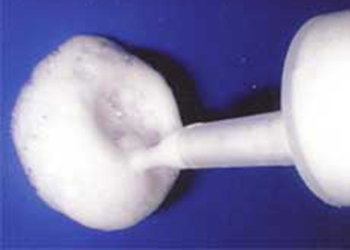 Sclerotherapy uses an injection of a special chemical (sclerosant) into a varicose vein to damage and scar the inside lining of the vein. This causes the vein to seals up. This technique has been used for many years to treat small varicose veins. Currently Foam sclerotherapy (mixing the sclerosant with air) is used to treat larger varicose veins.
Sclerotherapy uses an injection of a special chemical (sclerosant) into a varicose vein to damage and scar the inside lining of the vein. This causes the vein to seals up. This technique has been used for many years to treat small varicose veins. Currently Foam sclerotherapy (mixing the sclerosant with air) is used to treat larger varicose veins.
Following the procedure a bandage and stocking are applied on the leg which needs to remain in place for around 1 week. The stocking should be worn for a further week after the bandage is removed. Most patients are able to return to their normal routine immediately following this treatment. Complications are unusual but include bruising or discomfort around the needle site, phlebitis, a small area of skin discoloration overlying the vein and rarely, ulceration.
ClariVein
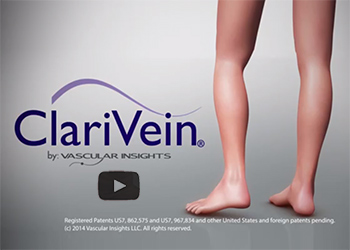 Clarivein is a minimally invasive technique for the treatment of varicose veins. It uses a combination of mechanical disruption of the inside lining of the vein and chemical injury using sclerosant solution. A fine wire is placed inside the vein. The wire rotates at a high speed that damages the inside lining of the vein combined with injection of liquid sclerotherapy.The combination of these two methods is an efficient and painless way of sealing the vein. This technique is even less invasive than the laser and VNUS Closure techniques requiring much less local anaesthetic infiltration.
Clarivein is a minimally invasive technique for the treatment of varicose veins. It uses a combination of mechanical disruption of the inside lining of the vein and chemical injury using sclerosant solution. A fine wire is placed inside the vein. The wire rotates at a high speed that damages the inside lining of the vein combined with injection of liquid sclerotherapy.The combination of these two methods is an efficient and painless way of sealing the vein. This technique is even less invasive than the laser and VNUS Closure techniques requiring much less local anaesthetic infiltration.
Cyanoacrylate Glue
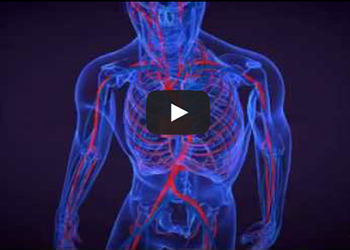 The system delivers a small amount of a proprietary medical adhesive to the diseased vein. The adhesive closes the vein and blood is rerouted through nearby healthy veins.
The system delivers a small amount of a proprietary medical adhesive to the diseased vein. The adhesive closes the vein and blood is rerouted through nearby healthy veins.
The Sapheon Closure System – VenaSeal is a new treatment using cyanoacrylate glue. It is currently considered a potential solution to different types of varicose veins.
The treatment is in the form of a simple injection under ultrasound guidance directly into the varicose veins to seal them. It is a quick and convenient treatment requiring a single minimal dose of local anaesthesia at the injection site during the procedure. No need for heating or burning and no compression bandage are required for this procedure. Patients benefit from a virtually pain free procedure and the ability to resume normal activity almost immediately.
Traditional Surgery
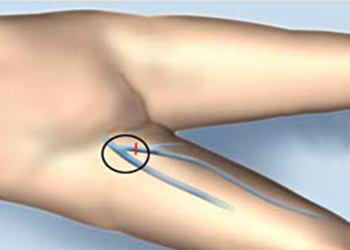 Surgery for varicose veins still has a place in the treatment of varicose veins and most patients are pleased with the results. This procedure has been around for over one hundred years but has become increasingly refined and the indications are few. Most surgery is carried out under a general anaesthetic as a day case (out of hospital the same day).
Surgery for varicose veins still has a place in the treatment of varicose veins and most patients are pleased with the results. This procedure has been around for over one hundred years but has become increasingly refined and the indications are few. Most surgery is carried out under a general anaesthetic as a day case (out of hospital the same day).
Ligation and stripping is a surgical procedure which involves tying off the affected vein before completely removing it. A 3cm skin crease incision is made in the groin and the connection between the main superficial vein in the thigh and the main deep vein is tied off. The superficial vein is then stripped out through an additional small incision (less than 1cm) on the inside of the knee. Small varicosities below the knee are removed through further incisions (less than 3mm in size) – these are called ‘phlebectomies’ or ‘avulsions’.
Complications of varicose vein surgery are generally uncommon but include bleeding, wound infection, nerve damage (patches of skin numbness), deep vein thrombosis and varicose vein recurrence.
Compression Stockings
The use of compression stockings is NOT a cure for varicose veins.
Although compression stockings help to reduce pain and swelling, they only help to manage symptoms and do NOT provide a cure. In fact, people with varicose veins may need to continue to wear these stockings for the rest of their lives. Most patients however do not like the way they look or feel. Your legs can get hot and sweaty. Stocking are available in graduated classes of increasing compression.
For reliable compression support all daylong

